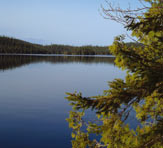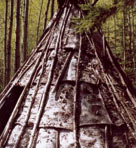  |
|
| |
Capacity-Building > How Much Capacity Do We Have? |
| |
|
| |
Go to: |
| |
Forestry-related capacity assessments of Aboriginal communities |
| |
Human resources: The Aboriginal workforce |
| |
Human resources: Aboriginal forest practitioners |
| |
Institutional capacity: Co-management, tenures, land use planning, etc. |
| |
Access to natural resources as capacity |
| |
Capacity of traditional Aboriginal societies |
| |
Capacity of non-Aboriginal parties |
| |
|
| |
|
| |
Forestry-related capacity assessments of Aboriginal communities |
| |
Social dimensions of community vulnerability to mountain pine beetle (MacKendrick and Parkins 2005) |
| |
This paper includes an assessment of 13 communities in B.C. and Alberta. One of them is a First Nation community.
"There is widespread recognition that the outbreak of mountain pine beetle will have significant social and economic impacts on forest-based comnmunities in British Columbia (BC). Although some communities can be assumed to be vulnerable owing to their proximity to infested regions, there is little knowledge as to the nature and extent of this vulnerability, representing a serious impediment to planning and policy making. This report presents the results of a vulnerability assessment in eleven communities in BC and two communities in Alberta located in regions experiencing various levels of mountain pine beetle activity.
To assess community vulnerability, this project first builds a vulnerability framework based on social science research in the areas of climate change, community capacity, hazards management and risk perception, as well as focus group meeting in five of the study communities. Variables and indicators included in this framework are then measured and combined into a vulnerability index, with index scores assigned to each study community. The spatial variation in vulnerability is further illustrated using Geographic Information Systems analysis.
The final assessment reflects that vulnerability is not simply a function of physical exposure to beetle activity, but also of various social, economic, and political factors that contribute to community adaptive capacity. Therefore, some communities loacated iun areas with high levels of beetle activity have less than expected vulnerability, owing to various capacities inheren in teh community, while in other areas with low to moderate levels of activity, vulnerability is somewhat elevated owing to a relative absence of these capacities." (Abstract) |
| |
(Return to top of page) |
| |
|
| |
Human resources: The Aboriginal workforce |
| |
December 18 - Report Shows Aboriginal Students Making Progress (BC) |
| |
Aboriginal Peoples and postsecondary education in Canada (Caledon Institute of Social Policy 2006) |
| |
The Aboriginal workforce: What lies ahead (Canadian Labour and Business Centre 2004)
|
| |
A brief overview of the capacity of the Aboriginal workforce and its importance in meeting the human resources needs of Business and Labour. This is not forest-specific. |
| |
National employer demand survey for foresters and forestry technicians (Canadian Council of Forest Ministers 2004) |
| |
Aboriginal people in Canada's labour market: Work and unemployment, today and tomorrow (Mendelson 2004 for Caledon Institute of Social Policy) |
| |
This paper is not forest-specific. |
| |
(Return to top of page) |
| |
|
| |
Human resources: Aboriginal forest practitioners |
| |
Council of the Haida Nation Forest Guardians (BC) |
| |
"The Forest Guardians were formed as a technical body for the Council of the Haida Nation. Our primary function is to track all forestry operations including the planning, layout, harvest, and deactivation process. Part of our mandate is to inform Haida citizens, and indeed all people of the islands. We strongly encourage people to become involved in the many issues that affect the lands and waters of Haida Gwaii." (from CHNFG website) |
| |
(Return to top of page) |
| |
|
| |
Institutional capacity: Co-management, tenures, land use planning, etc. |
| |
Our Institutions section includes a provincial/territorial inventory of institutional arrangements for Aboriginal rights and participation in the forest sector. |
| |
(Return to top of page) |
| |
|
| |
Access to natural resources as capacity |
| |
Anderson, R., and C. Barnett. 2006. The Indigenous land claims in New Zealand and Canada: From grievance to enterprise. Regina, SK: Saskatchewan Institute for Public Policy. |
| |
|
| |
|
| |
Capacity of traditional Aboriginal societies |
| |
Trosper, R. 2003. Resilience in pre-contact Pacific Northwest social ecological systems. Conservation Ecology 7(3): 6. |
| |
"If, like other ecosystems, the variable and dynamic ecosystems of the Pacific Northwest exhibited cycles and unpredictable behavior, particularly when humans were present, the indigenous societies of that region had to have been resilient in order to persist for such a long time. They persisted for two millennia prior to contact with people from the “old world.” The Resilience Alliance (2002) proposes that social and ecological resilience requires three abilities: the ability to buffer, the ability to self-organize, and the ability to learn. This paper suggests that the characteristics of the potlatch system among Indians on the Northwest Coast, namely property rights, environmental ethics, rules of earning and holding titles, public accountability, and the reciprocal exchange system, provided all three required abilities. The resulting resilience of these societies confirms the validity of many of the ideas now being discussed as important components in providing successful and sustainable relationships between humans and their ecosystems. That so many separate ideas seem to have been linked together into resilient systems in the Pacific Northwest suggests that social ecological resilience is complicated." (Abstract) |
| |
(Return to top of page) |
| |
|
| |
Capacity of non-Aboriginal parties |
| |
B.C also needs to build capacity (North Island Gazette, September 28, 2006) |
| |
|


